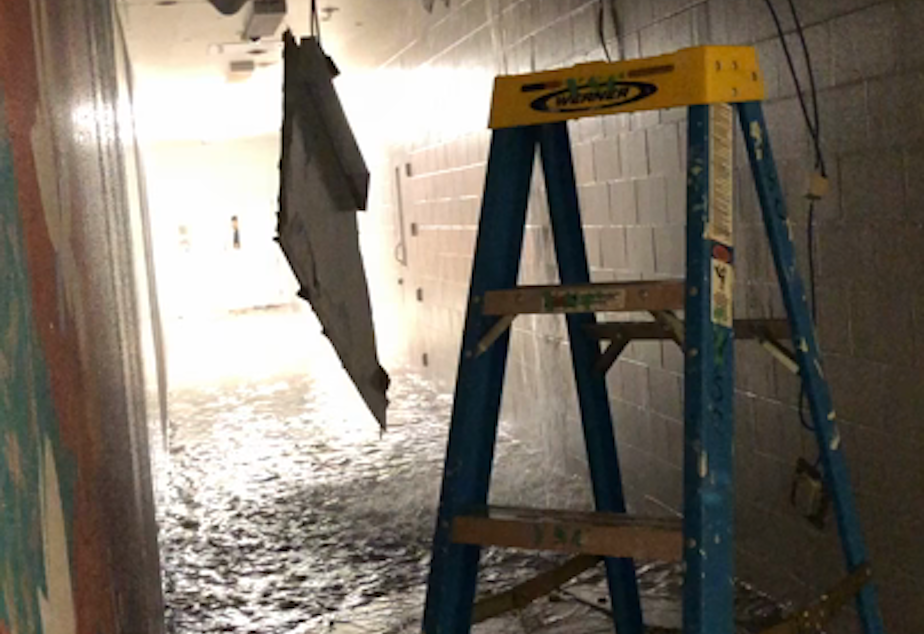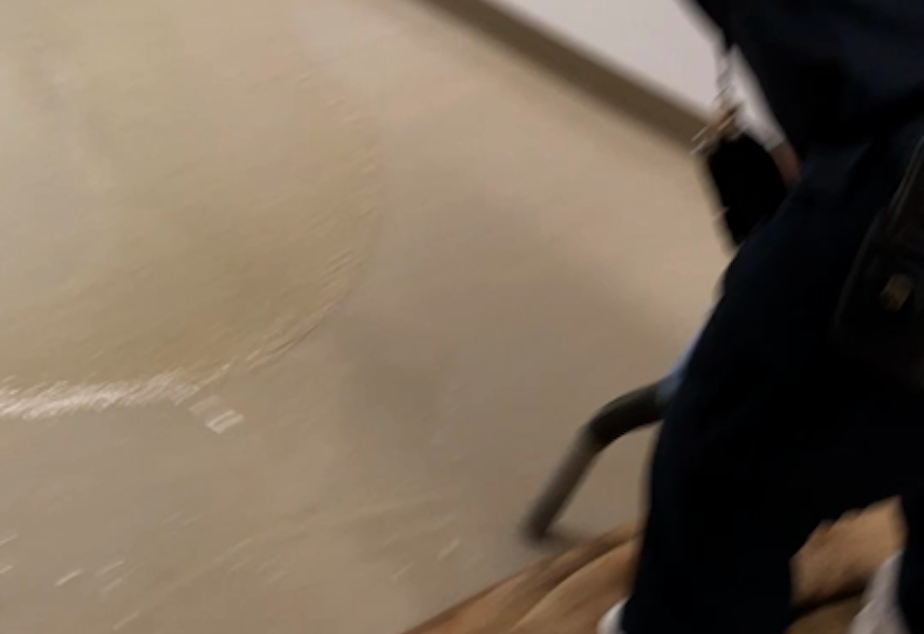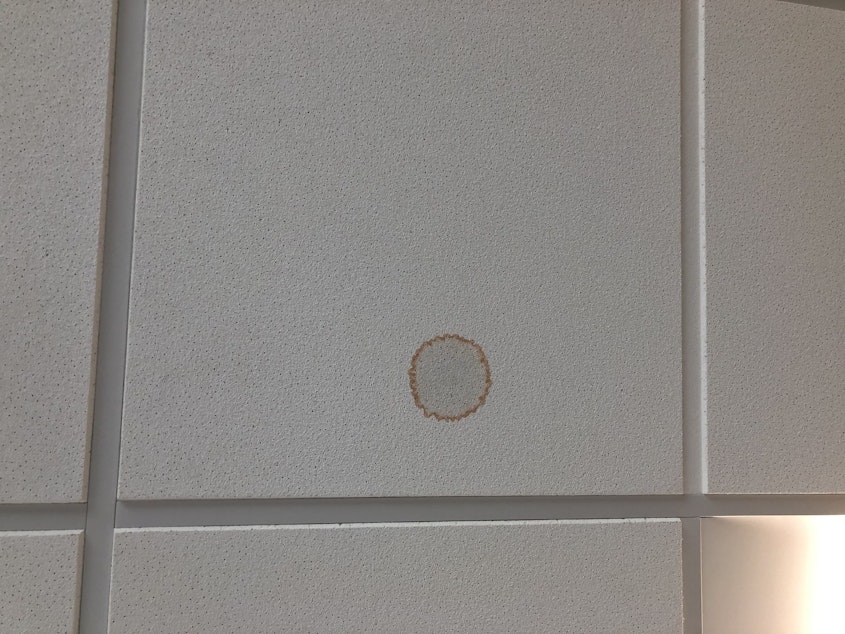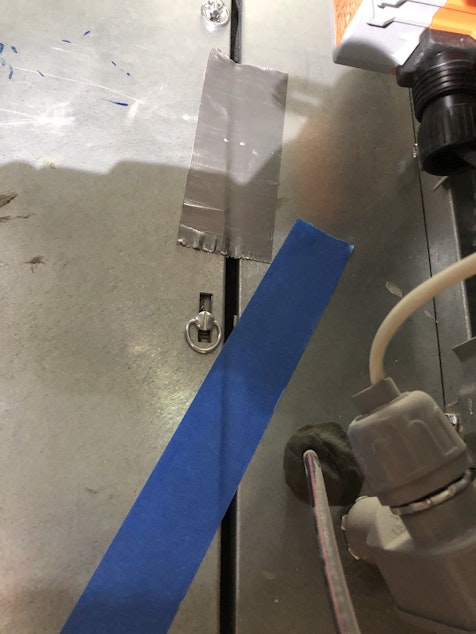Floods, faulty toilets, and a slew of early defects at Seattle’s new youth jail

T
he building leaked from so many places, jail leaders considered adding rain gear to their uniforms. Toilets wouldn’t flush. In one part of the ventilation system, bare wires. And in another, duct tape.
The Judge Patricia H. Clark Children and Family Justice Center in Seattle opened in February 2020, two years later than planned. In the end, the budget grew to $243 million, $33 million more than King County had originally envisioned.
It replaced the old juvenile jail and courthouse, called the Youth Services Center, which was in disrepair and beset by maintenance issues. The county envisioned the new facility as a “modern,” “respectful,” and “therapeutic” place where young people and families could access help they needed, under one roof.
Sponsored
Its construction became a flashpoint for activists who saw it as driver of racial injustice and called for the county to end youth detention. But the center was built, and it won multiple design and construction awards.
While the building shines on the surface, its mechanical innards – the plumbing and HVAC systems, specifically – had an “egregious” number of problems, according to two construction experts KUOW interviewed.
The issues included several floods, numerous broken or missing plumbing fixtures, and wildly fluctuating air temperatures. KUOW reviewed hundreds of pages of court records and county documents obtained through public records requests, such as internal emails, contracts, work orders, punch lists, meeting minutes, project status reports, photos, and videos.
The most numerous problems arose in plumbing and HVAC systems installed by one subcontractor, the Tukwila-based Holaday-Parks Inc., according to the county’s internal log of facilities issues that contractors were responsible for fixing under warranty.
Holaday-Parks has not responded to multiple requests KUOW has made for comment.
Sponsored
The project contractors have repaired the issues that fell under their warranty at no cost to the public, according to county officials.
“I'm not happy that we have those problems, I’d prefer not to. I am pleased with the responsiveness of our general contractor in addressing them,” said Anthony Wright, director of King County’s Facilities Management Division, which is responsible for county construction projects, buildings, and real estate. “But there are more than we should be dealing with.”
After the warranty ended, though, some issues have continued.
As for the young people detained at the Children and Family Justice Center (CFJC), they’ve been periodically shuffled from one “living hall” to another to keep them safe and dry from flooding, or to make space for contractors fixing plumbing defects.
An average of 26 young people a day were detained at the CFJC in 2020, and an average of 22 were detained in 2021, according to county data.
Sponsored
The relatively low number of detained youth minimized the amount of disruptions, director of juvenile detention, Allen Nance wrote in a statement to KUOW.
“The impacts on Juvenile Division operations have been minimal, and we have had ample space to move operations within the facility to accommodate repairs,” Nance wrote.
Gushing water
One plumbing failure started small: A bolt was too loose.
The impact was dramatic.
Sponsored
April 2020 – a few months after the building opened – that bolt, and the six-inch pipe it was supposed to clamp together, broke free.
Water cascaded from the ceiling and flooded the first floor. Elevator shafts filled, and chunks of drywall floated down the hall.
Water gushed out at 80 gallons a minute for an hour and a half, according to a lawsuit filed by Holaday-Parks in King County Superior Court against its subcontractor Redline Plumbing.
The suit claims Redline breached its subcontract by improperly installing the pipe that burst and damaging the Children and Family Justice Center.
Redline claims the pipe in question isn’t covered by its contract, and Holaday-Parks should have caught the error. Holaday-Parks says it is within Redline’s scope of work.
Sponsored
Court records show both parties agree that the pipe was improperly installed.

 1 min
Video taken by director of juvenile detention, Allen Nance April 24, 2020.
1 min
Video taken by director of juvenile detention, Allen Nance April 24, 2020.
“Who would have thought that a flood in our brand-new building would have been a possibility only two months after moving into the space?” wrote Allen Nance, director of juvenile detention, in an email to staff the evening after the flood.
Nance focused on the positive and congratulated his staff on their response to the emergency.
“I am proud and honored to work shoulder to shoulder with many of you as we tackled the seemingly unending flow of water with mops, squeegees, brooms, vacuums, blankets and just about anything else we could use to keep the water at bay,” Nance wrote. “Thanks to you, we kept it from the living halls and pushed it to the sewers.”

 1 min
Video taken by director of juvenile detention, Allen Nance April 24, 2020.
1 min
Video taken by director of juvenile detention, Allen Nance April 24, 2020.
The Department of Adult and Juvenile Detention declined KUOW's request for an interview with Nance.
It would take months and more than $4 million to fix the damage. General contractor Balfour Beatty – operating locally as Howard S. Wright – footed the bill.
They passed it on to their subcontractor, Holaday-Parks, which is currently suing its subcontractor, Redline Plumbing, for damages, attorneys’ fees, and interest. A trial is set for October.

Plumbing and air flow complaints
Some other issues with the facility seem banal – absurd, even – but they’re red flags for some construction professionals.
KUOW obtained the county’s internal log of building issues that contractors were responsible for fixing under warranty. The county documented more than 300 issues in work performed by Holaday-Parks between December 2019 and November 2020 — that's nearly half of all defects identified at the building during that time, according to the log.
Many contractors who took part in the youth jail construction had a handful of issues to fix, but Holaday-Parks had hundreds more than any other contractor.
After the building was occupied, more than 60 problems cropped up with toilets that wouldn’t flush. Others wouldn’t stop flushing.
The drains wafted sewer smells because key plumbing parts were either missing or broken.
Water leaked from pipes, sinks, ceilings, and windows.
It pooled in the showers and behind walls.
While those issues have been fixed by the contractors at no cost to the public, other problems have since cropped up.
The warranty period for the jail and courthouse expired November 2020, according to Cameron Satterfield, a King County spokesperson, and the county is on the hook for maintenance costs going forward.
As of late July, maintenance this year has cost over $1 million, according to Satterfield. That’s above average for building maintenance in the Pacific Northwest, according to industry benchmarks compiled by the International Facility Management Association.
A more recent internal log of facility work orders, obtained by KUOW through an open records request, shows that complaints of leaks, faulty toilets, and sewage odors have continued into 2022.

While the water wouldn’t stop, the ventilation system seemed to have the opposite issue — the air wouldn’t flow.
In internal emails, a former building operations supervisor called the HVAC system a “nightmare.”
Sometimes it even screeched.
During the first summer in the pandemic, one judge worried the stagnant, hot air was a Covid threat, according to an internal email.
Judge Averil Rothrock contacted the facilities department in August 2020 requesting the temperature be lowered 6 degrees and, at one point, describing that, "everyone in the courtroom was aware that the air is not working correctly; it was hard going. This is not a comfort issue."
Judge Says Airflow is a Safety Issue
At other times, the rooms were frigid. When bailiffs used a space heater, they tripped the circuit breakers.
Some parts in the HVAC systems were improperly installed. One maintenance employee found duct tape holding a heating and cooling unit closed.
“More duct tape, please not duct tape, not this time,” facilities maintenance constructor David Rauen wrote to higher-ups in an April 2020 email, documenting leaks and improper installations with photo attachments.

Wonky wiring
The electrical system had issues too, according to internal email threads between maintenance employees, supervisors, and project managers. Employees reported bare wires on some devices meant to block smoke from entering the ductwork during a fire.

“OMG…HORRIBLE,” wrote operations engineer Eddie Shahwan, in respone to a photo of a wire that pulled loose from a controller in the HVAC system late March 2021. The email thread continued for a few days with maintenance employees sharing four more photos of wiring issues.

“This is getting too ridiculous finding all this at project completion,” Shahwan wrote in an email to project managers.
Typical woes, or red flags?
Small issues can have bad consequences. Leaks can cause mold, which can hurt indoor air quality, according to the Northwest Clean Air Agency and Environmental Protection Agency. Sewer odors may contain harmful gasses such as carbon dioxide, hydrogen sulfide, and methane.
King County officials have claimed problems like these are common in new construction. KUOW reached out to construction industry professionals for perspective on the scope of the defects and repairs, but most of the seven local contractors and industry representatives KUOW contacted declined to comment for this story.
“It certainly seems like an egregious amount of problems,” said Patrick Kolanda, who heads the Construction Management Department at Edmonds College. At KUOW’s request, he reviewed the county’s log of items in need of repair.
“There are so many issues that it certainly raises some serious questions about quality, quality control, and whether the taxpayers were well served on this job,” he said.
Nearly a third of the issues with Holaday-Parks’ work relate to plumbing defects, such as malfunctioning toilets, so we also sought the opinion of a plumbing contractor.
“Why aren't the toilets flushing? That's kind of a red flag to me,” said Jeremy Pavlich, a master plumber who reviewed King County records shared by KUOW.
“It’s not that hard to get them to flush. It’s not like this is an impossible feat.”
Pavlich is based in Beaumont, Texas. He is licensed at the highest level in the state, instructs apprentices, and has 20 years of plumbing experience — including in big casino and university building projects.
Even a narrow pipe under pressure can cause extensive — and expensive — damage if it fails, Pavlich said.
As for that pipe connection that burst and caused that major flood? It’s one of the easiest joints a plumber can install, he said.
“It's literally two bolts,” Pavlich said. “When I saw that, I was like, 'There's no testing, there's no QC [quality control]. They just rocked and rolled with it.'”

All of the plumbing in the building was inspected by Public Health — Seattle & King County, according to a spokesperson for that department. Public Health has approved plumbing permits for 1211 E Alder Street, the justice center’s address, four times since 2017, according to the department’s online permit status website.
However, the pipe that burst wasn’t tested under pressure as it should have been, said Anthony Wright, who directs the county’s facilities division.
That’s the contractors’ responsibility, according to documents in a pending lawsuit.
And yes, there were a lot of issues with the building that needed to be fixed under warranty, Wright said. Still, you can’t compare it to a house, apartment, or office building, he said.
“I think the point I would bring about this building is it's extraordinarily complex,” he said, and that complexity has contributed to its issues.
The county may evaluate whether it needs to change how it assures quality of a new building, he said.
“We're not going to make a dramatic change in our approach, because I don't see this as being a substantial and repeatable issue,” Wright said. “I see it as a problem, and a problem with a particular aspect of the construction. And we're going to fix that. And ideally, we could catch it a little earlier.”
General contractor Howard S. Wright, which was ultimately responsible for the design and construction of the justice center, declined multiple interview requests.
“All building systems underwent and met extensive quality assurance and control requirements, including a review and inspection of its design and installation by the County’s third-party commissioning agents,” a spokesperson for the contractor said in a written statement.
The items in need of fixing under the warranty “were addressed, repaired and resolved expeditiously and satisfactorily as accepted by the county,” the statement said.
Jail leaders defend the new building, despite the setbacks.
“From our standpoint, the new building offers a vast improvement over the Youth Services Center that it replaced,” Nance said in a written statement. “The environment is healthier and more conducive to therapeutic service delivery for youth in our custody and care, and enhances our capacity to meet the individualized needs of each youth.”




